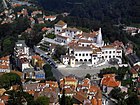- ↑ Taurino, João. "Palace and Quinta da Regaleira - Visit Sintra". visitsintra.travel. Retrieved 2023-05-12.
- ↑ "Inside the Initiatic Well - Picture of Quinta da Regaleira, Sintra - TripAdvisor". www.tripadvisor.com.
- 1 2 Cardosa, Fernando Teixeira & Izabela. "The mysterious inverted tower steeped in Templar myth". www.bbc.com. Retrieved 2023-05-12.
- 1 2 "Templar Secrets of Sintra's Mysterious Initiation Well". Messy Nessy Chic. 2023-02-17. Retrieved 2023-05-12.
- ↑ Tom. "Quinta da Regaleira: Occult Initiation Wells Steeped in Mysticism". Urban Ghosts. Retrieved 4 May 2018.
- Portuguese Association for Investigation
- "Rotas & Destinos" magazine
- Quinta da Regaleira: Sintra Portugal. Fundação Cultursintra
- Anes, José Manuel (1998, interviewed by Victor Mendanha). O Esoterismo da Quinta da Regaleira. Lisbon: Hugin
- Anes, José Manuel (2005). Os Jardins Iniciáticos da Quinta da Regaleira. Lisbon: Ed. Ésquilo
- Adrião, Vitor Manuel (2006). Quinta da Regaleira: A Mansão Filosofal de Sintra. Lisbon: Via Occidentalis Editora
- Veigas, Ana Sofia Fernandes (2007), Para uma Antropologia do Símbolo Estético: o paradigma da Quinta da Regaleira, Lisbon, Faculdade de Letras da Universidade de Lisboa
External links
Wikimedia Commons has media related to Quinta da Regaleira .
| Quinta da Regaleira | |
|---|---|
 | |
 | |
| General information | |
| Location | Sintra, Portugal |
| Part of | Cultural Landscape of Sintra |
| Criteria | Cultural: (ii), (iv), (v) |
| Reference | 723 |
| Inscription | 1995 (19th Session) |
Cultural landscape of Sintra | ||
|---|---|---|
| Palaces | ||
| Religious | ||
| Civic | ||
| Nature | ||
| Miscellaneous | ||
